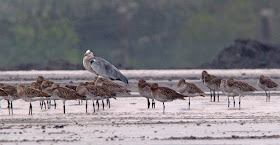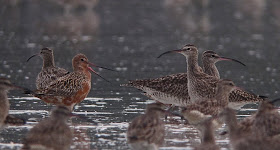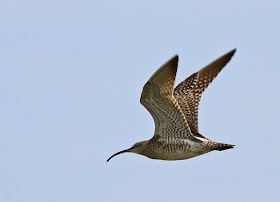This was a challenge, as at least one of our number had not yet seen Far Eastern Curlew.

The bird at the front, two right of the Grey heron, looked significantly darker through the scope. This photo shows, however, that it was a Eurasian, and that the darker appearance was caused by the bird being in breeding plumage, giving it a much richer background colour to the breast and flanks than the others.

We went to the coastal bund as the tide dropped to watch the birds fly out to feed, and I was pleased to photograph the same or a similar bird in flight (top right). The apparently small size and short bill suggests that it's a male, so perhaps, like the godwits, males tend to moult into breeding plumage earlier than females. Note also the enormously long bill of the left hand bird (probably a female). I may sound like a broken record, but bill length is NOT a useful feature in separating 'orientalis' Eurasian from Far Eastern Curlew! We did get one by the way - or some of us did. Unfortunately, it was in a larger flock and those who especially 'needed' Far Eastern did not get onto the bird before it disappeared behind the mangroves. Ah well - next time!

I didn't take many pictures of Whimbrels at the roost this time, but liked the light and the contrast with the godwit in this one.
I did, however, take many pictures of Whimbrels as they flew off to feed, as I'm interested in the range of variation in underwing barring. Here are just a few!







There seems to be quite a variation in the extent of barring on the underwing coverts and flanks. This could be related to state of moult at this time of year though. More work needed!
No comments:
Post a Comment